WORLD CLASS COACHING
How Pep Guardiola Wins with Inverted Fullbacks
By Mike Smith
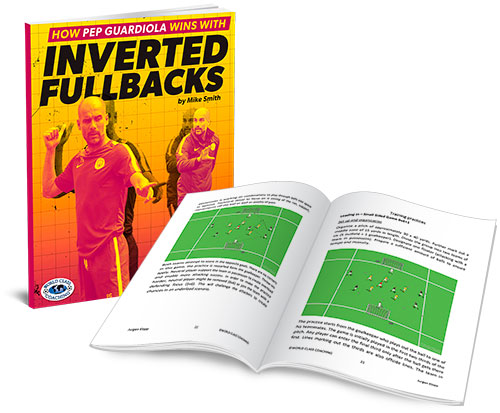
Table of Contents
PART TWO
TACTICAL ADVANTAGES OF INVERTED FULLBACKS
TACTICAL ADVANTAGES OF INVERTED FULLBACKS
My grandfather always told me “Michael, if you want to make sure you make and keep lifelong friends, never talk about religion or politics.” I have found this to be sound advice, and after 20 plus years of coaching, I would put tactics as a close third on this list. I don’t think I have ever lost a friend after a serious tactical discussion, but I can’t really remember a time when any of these discussions ever determined who was “right.”
I will cover these 5 distinct tactical advantages of playing with inverted fullbacks: 1. Creates a Numerical Advantage in Every Line 2. Allows for Connecting and Pivot Points Across the Length and Width of the Field 3. Stifles Many Counter Attacks/Nullifies the Wings 4. Allows for a Very Aggressive Attack 5. Creates Great Shape for Possession.
The Numerical Advantage
The number one advantage of the inverted fullback is the idea of creating a numerical advantage. Actually, this numerical advantage is not always seen as far as overall numbers in an area, HOWEVER, because of the spacing and multitude of triangles created, even when “numbers down,” Manchester City is usually numbers up within the triangles created by their spacing. The fullbacks are especially involved in directly creating numbers up in both the defensive and midfield lines. Because of this, Man City can take an already potent 3 forward attack and engage additional midfielders aggressively on every possession. It is almost like having 5 players in every line all the time. For example, in this clip from before (below), the clear movement of the fullbacks up to mark centrally, combined with the center backs and holding mid, basically creates a 5 man back line, which serves well to handle a 3 forward attack.
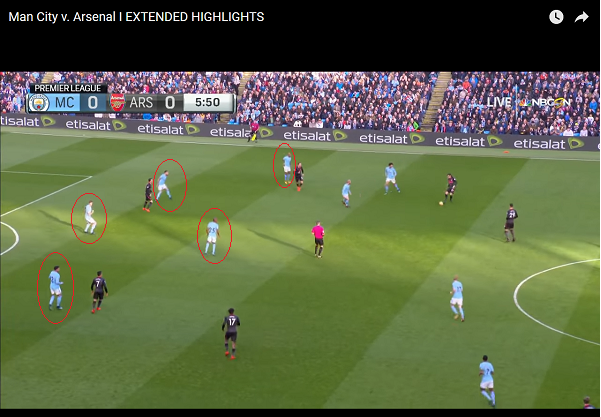
This clip shows a staple part of the inverted fullback concept. Manchester City is basically inviting teams to play in the wide areas of the field by banking on the fact their pressure will win the ball when their opponent attempts the wide play. This goes against traditional wisdom. There is another component here I should have addressed earlier as a condition to make the inverted fullback concept work: the wing play of the top 3. Manchester City’s attacking players willingly work back into the mix, as seen in the above clip applying pressure to the ball. I did not mention this as it is not a new concept and many teams which play 3 up top utilize these players on the wings for defensive support. It does play a significant role, however, in creating numbers up and “baiting” the opposing side into playing into the center.
Most teams attempt to create “numbers up” around the ball, but just having more players in a certain area does not dictate success. The idea then becomes more about where the numbers are, and in a lot of respects it can be a gamble. Manchester City has gone all in with the use of the inverted fullback which, while appearing to open up the wide areas of the field, has actually nullified the wing play, which is a staple of many teams. The clip below shows a 50/50 ball being squarely attacked (and won) by the inverted fullback. As mentioned previously, the inverted fullback’s main area of focus is in between the opponent’s forward and midfield line. This aggressive approach forces the opponent to compact themselves immediately or surrender possession. This clip shows the inverted fullback helping to speed a quick transition to attack.
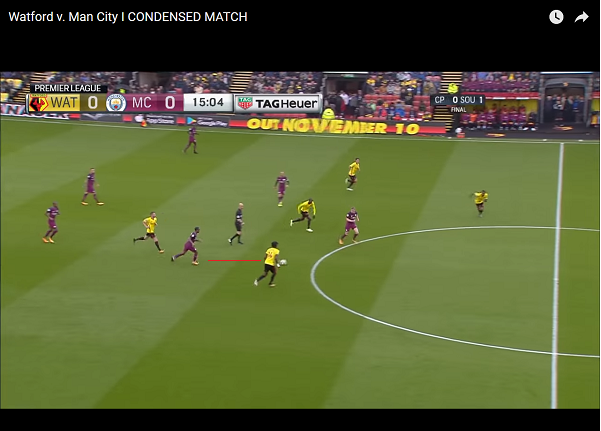
The ball is subsequently sent from the inverted fullback to the midfielder and then through to the oceans of space the forwards now have to work with (following clip).
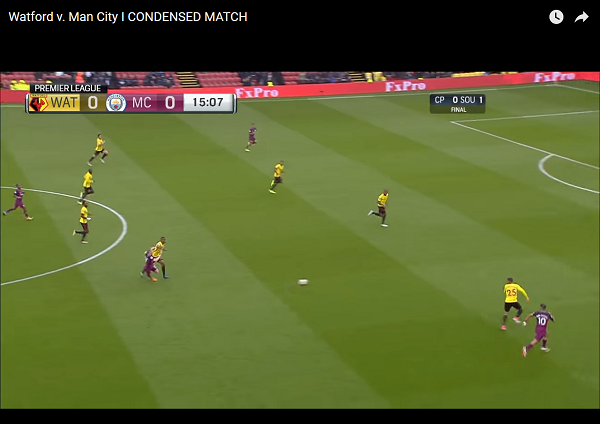
The next clip shows a more purposeful look at this idea of getting 5 players in good shape and baiting the opponent into losing possession. Feeling confident in a 9 v 5 advantage coming out, Watford attempts to get the ball into the feet of their midfielder. However, the aggressive central play of the inverted fullback springs the trap. While Watford does have a numerical advantage in a large section of the field, Man City clearly has numbers (5 to be exact) and open players around the ball.
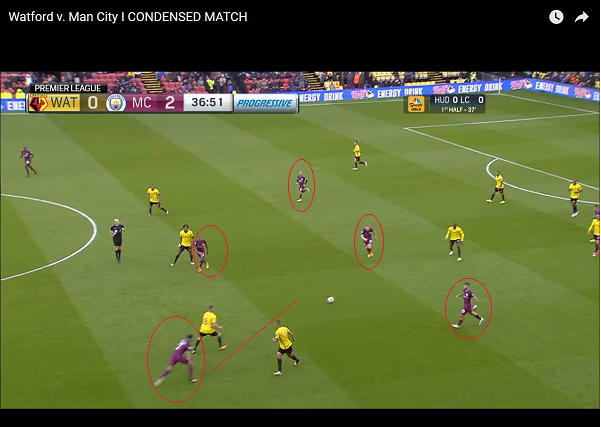
A good win from a player (the inverted fullback) who would “traditionally” be out on the wing, combined with a good pass to the open forward who is working back on the ball side to support and the 5 are poised to attack (below).
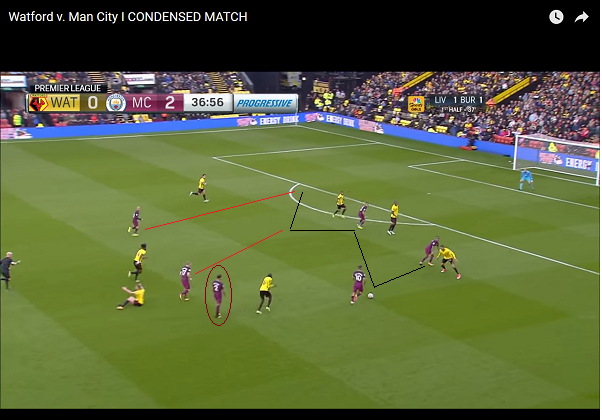
Still referencing the above clip, a 3v3 is on with trailing players closing quickly to create a 5 v 4 advantage for Manchester City. While the inverted fullback (circled) was initially part of the 5 in the midfield transition, he now holds to let the final wave of 5 execute the attack.
Even those who argue the 4 player back line is not the “norm,” most coaches agree on the need for extra numbers at the back. And, most coaches realize the extra numbers in the back are often wasted from an attacking standpoint. Thus, the idea of the overlapping back, working wide up the line or perhaps coming in to finish a service or cross from the far side are fairly common practices at every level. What is uncommon is getting the outside back into the attack in the central areas of the field. While common sense would suggest this exposes the wing areas to a counter attack, and it does, Man City’s aggressive approach forces teams to utilize their wing players centrally or give up unchallenged possession. These ideas will be looked at a bit further on. Below is one more example of the inverted full back not only pushing play centrally up the field, but getting squarely involved in the attack.
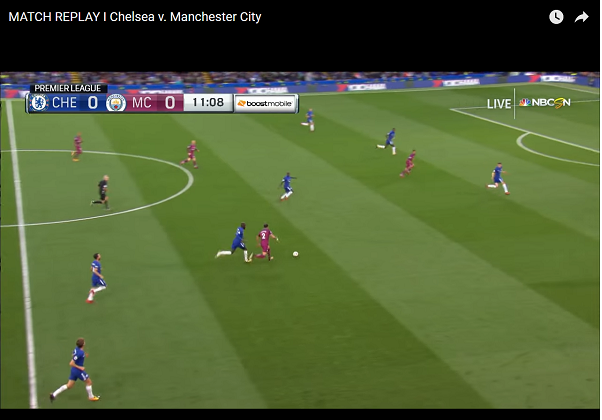
The inverted fullback (Walker #2) is driving the ball straight into the best distribution point on the field. This time however, after distributing to the open supporting player coming in, he stays up into the attack as part of a group of 5 (following clip).
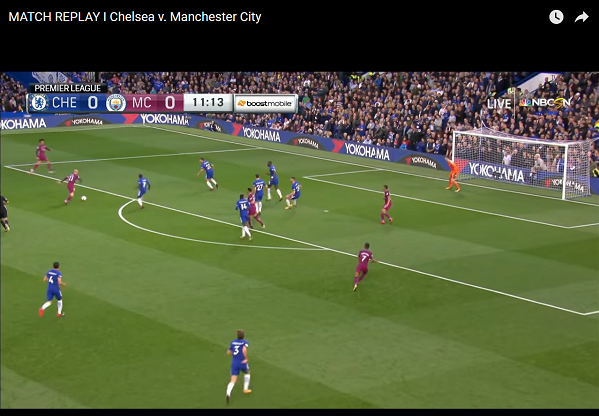
It does sound crazy in a section on numerical advantage to suggest the team of 5 has the advantage over the team of 9, but as the above clip shows, this is exactly what is happening. At the top left of the clip, Manchester has a clear 2 v 0 at the top of the box. The inverted fullback compacted play centrally so quickly the defenders have left 2 attackers in a 2 v 1 versus the keeper on the weak side as well – and this is against Chelsea. As touched on previously, should Manchester City choose to hold possession, they have a 5 v 2 off screen. It is a win/win and they are doing it against some of the highest level of competition in the world.
The following diagrams illustrate the exact numerical advantages playing the inverted fullback provides within the various triangles their shape provides.
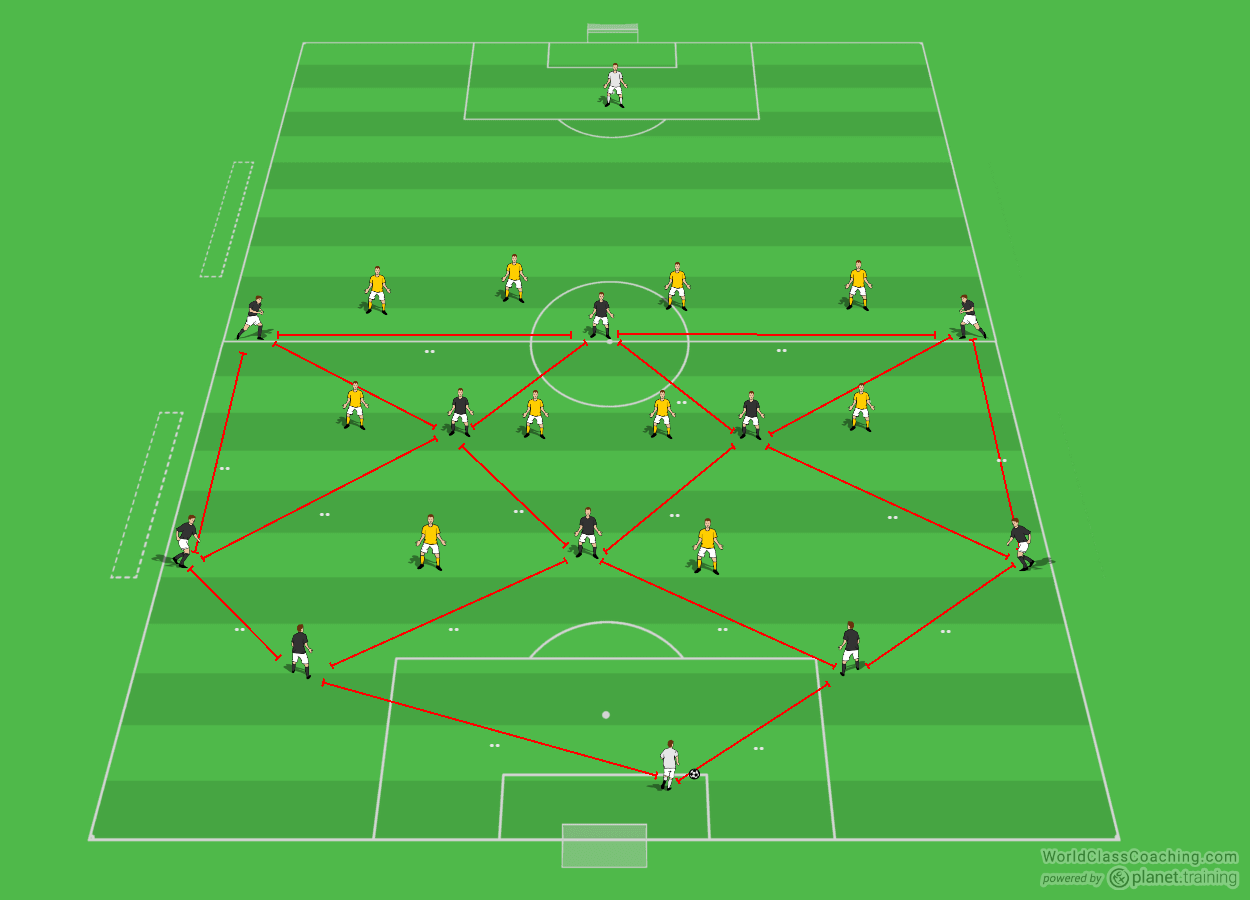
The red lines are not passing options (above). Note the 4 v 1 created between the back line and mids of the attacking team (black). All 3 lines then combine to create 3 v 1s on the wings and a 4 v 2 in the middle. While the backs are not inverted here, this is the way Manchester City plays out most of the time on goal kicks and keeper possessions. Once the ball is sent out wide to the outside back, rather than forcing play up the line into a numerically inferior 3 v 4, clogging the middle and making play predictable, Manchester City’s outside backs most often choose to invert and go central (following diagram).
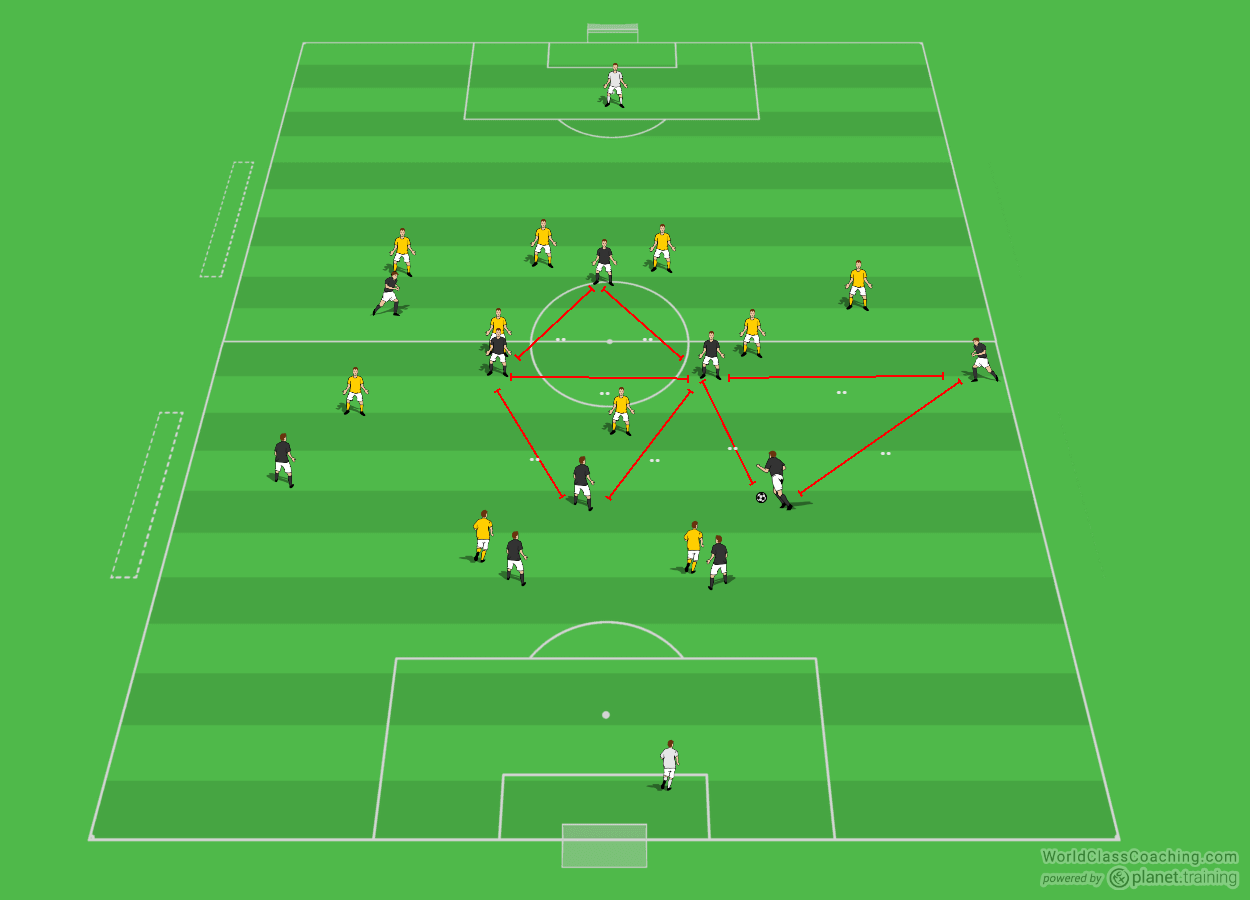
The defending side (yellow) must adjust to the numerous connecting options. The above diagram shows only those triangles created once the fullback inverts and, combined with the adjustment the defending team must make to even hope to apply pressure, there is now a 4 v 1 in the center and a 5 v1 when adding the wide forward into the mix. One could argue the numbers on the outside right are a 3 v 0 as well.
Even when pushed squarely into attack (and my diagram below looks more compact here than it actually does on the field) the number of 4 v2 and 3 v 1 scenarios is staggering.
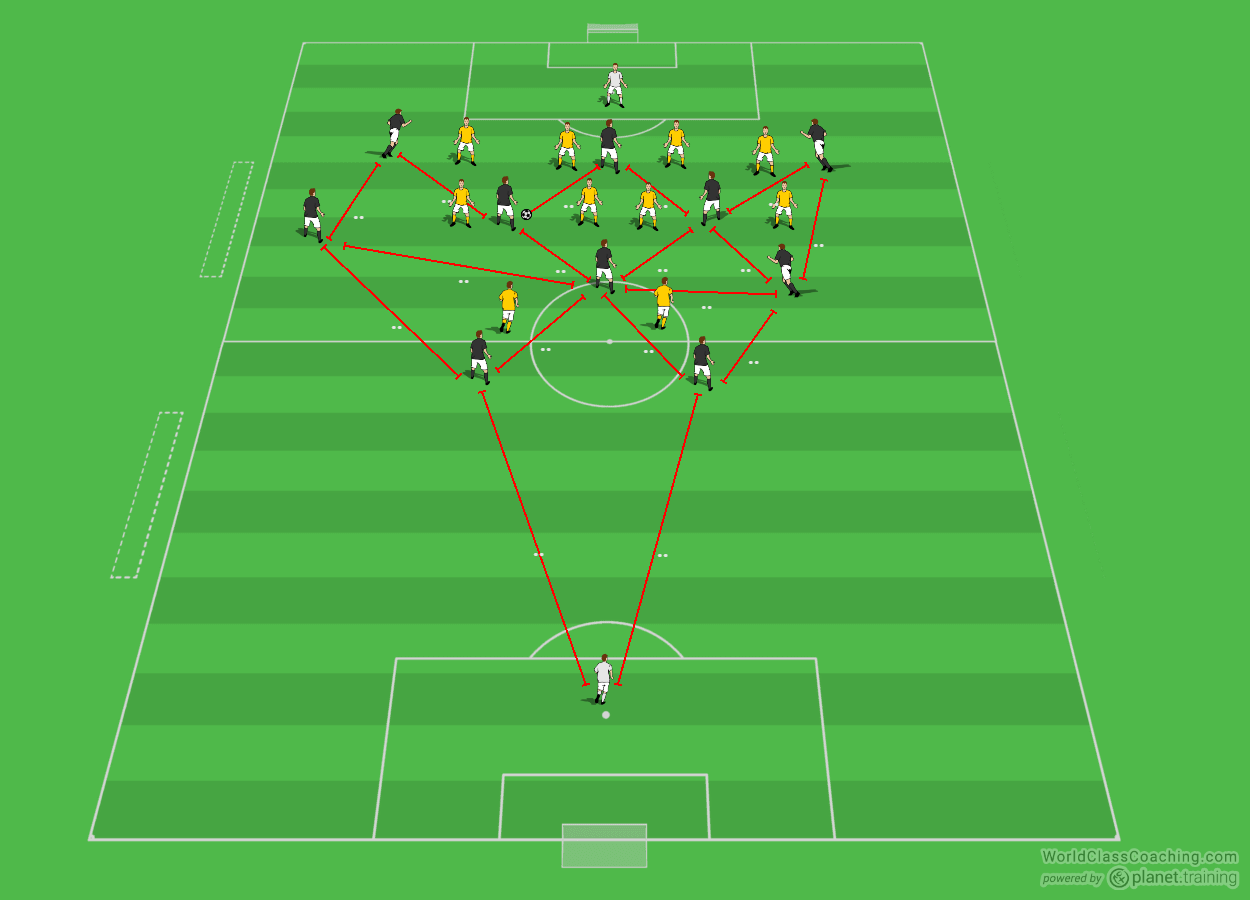
The final diagram sheds light on the only glaring weakness playing an inverted fullback brings, and there is a whole chapter dedicated to this coming up. In the diagram below, note the two red triangles making areas where IF possession is lost, the defending team can quickly play out with a 3 v2 advantage. Teams are creating some chances against Manchester City this way but because Man City’s players are constantly aware of this, as the second diagram below shows, they usually recover well, with only the quickest of counters actually posing any real threat.
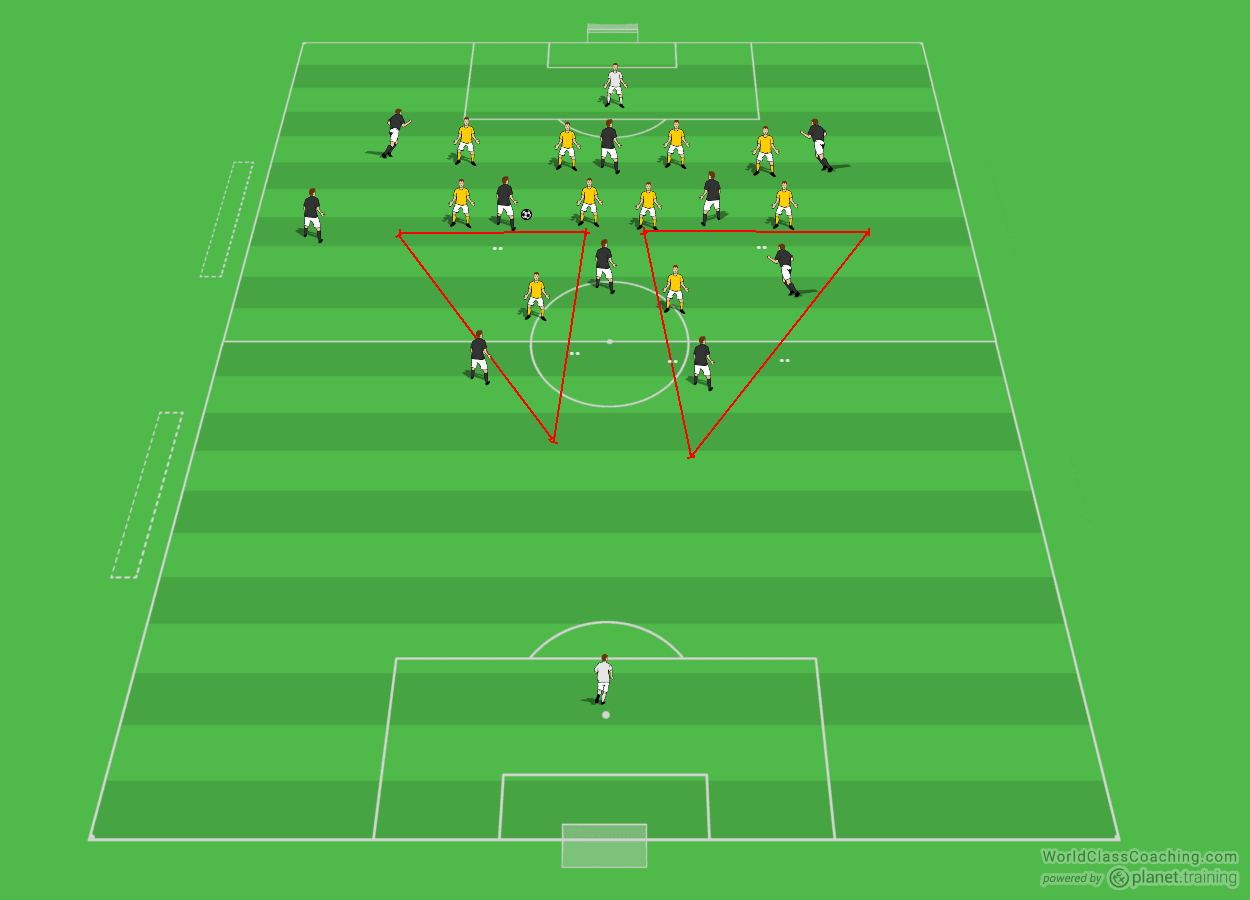
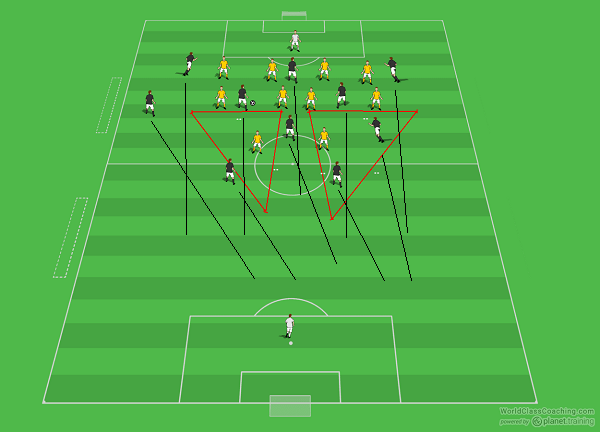
Connections
Once the inverted fullback has helped create the numerical advantage the lines and groups of 5 provide, the big tactical advantage becomes the ease of which Manchester City can connect the entire field. Traditional wisdom seems to suggest immediately getting the ball wide and either spreading out your opponent to exploit gaps or keeping possession while they park the bus (pack 8 – 10 men inside the box) is the way to play. It works. However, if one breaks down what is happening, the wide first approach funnels everyone into the same small area, which is actually the area the attacking team wants to open AND puts the only open space (the far side) squarely out of reach for attacking purposes. This should be seen as an advantage for the defending team as traditional numbers would put 8 defenders plus the keeper going against 6 or 7 attackers, with only 3 or 4 of those attackers actually posing a shooting threat. The following clip demonstrates the “counter” logic having the fullbacks play inverted provides.
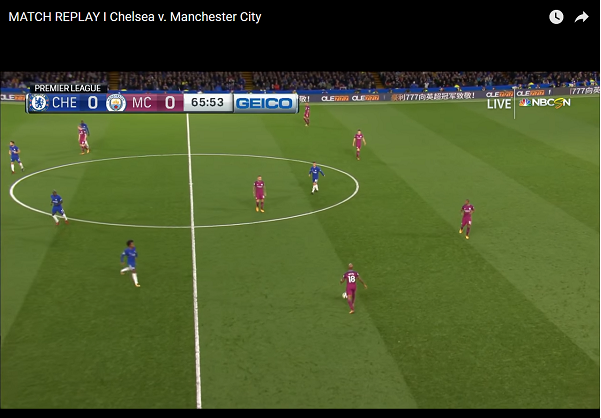
In this clip (above), the inverted fullback (Delph # 18) has immediately turned toward the center (in) and is able to connect with several players in several areas of the field. The player to 18’s immediate right is actually the holding mid. There is another center back off frame to the bottom right. When building up from a goal kick, as shown previously, Man City sends their center backs to the top corners of the penalty box. Many times, the fullback is out there with them on the line. As the backs push up a bit wide, as a back line of 4 traditionally does, even more space is created centrally and once receiving the ball the fullbacks look to invert. The same clip shown again below with markings shows the impact of this turn in.
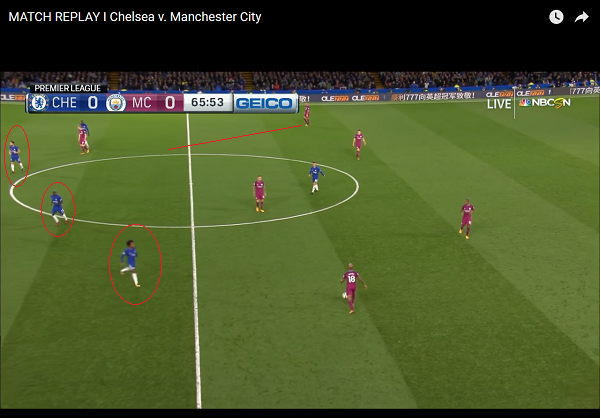
Because the left wing is still an option (and a Man City forward is up there) the two Chelsea defenders at the top left of the screen (circled) must turn their bodies and be aware of the man out wide. Again, Manchester City’s top 3 do a great job of providing width. The remaining Chelsea player (circled left center) must at least apply passive pressure to the ball handler. Just the act of inverting itself now opens up the entire field immediately to Manchester City, allowing them to pivot their point of possession/attack at will and KEEP their opponents pushed back in their end.
While there are 3 additional tactical advantages to cover, the advantages of numbers up in every line and the ability to connect the entire field seamlessly are the two main benefits of using the inverted fullback. When compared to the traditional 4-4-2 for example: The back line of 4 connected the width of the field using a 4 v 2 advantage (5 v 2) including the keeper. Two solid strikers would push up for a long ball and they would hold the attention of the opponent’s back 4. Now the battle is in midfield – but once a wing is chosen – the opposition fills in the center, pressures the ball and essentially, the opposite wing is cut off. Should an opportunity for an attack arise – great – if not, conventional wisdom state drop it back, reset on the back line, and try it again. This type of play was/is allowed because the field is just too big to cover – even when using only the center and one wide area. The inverted fullback expands the field, especially the wings, by forcing the opponents to choose between being dominated by possession, spreading out too far/too early, or compacting play centrally too high and too early. With strong central backs, a disciplined holding mid, and forwards who readily work back and provide width, the inverted fullback is simply a game changer.
Eliminates Most Counters/Nullifies Opposing Wings
On paper, the idea of pushing outside backs up and into the center seems like an open invitation to get countered on the wings, and there is a weakness to be exploited here. However, the majority of counter attacks come from, in my opinion: 1. Mistakes by the Possessing Team, 2. Good Play Making by the Defending Team,3. Poor Attacking Team Shape and 4. Poor Recovery. Manchester City’s inverted fullback approach ENSURES good possession, LIMITS playmaking by the defenders everywhere except their defensive third, provides STRONG ATTACKING OPTIONS and Manchester City RECOVERS WELL.
Provides Aggressive Attacking Options
While it is common to assume every time a team has good possession of the ball there will be an attack, there is a difference between possessing and attacking. Many teams, although moving quickly up the field, take the time to “build” into an attack, especially against a good, defensive minded side. With their use of the inverted full back, Manchester City intends to, or is prepared to attack almost immediately every time they have the ball. In essence, the inverted fullback showcases their aggressive attitude, team speed and quickness as their key strength. The diagrams used in the following section of possessing shape, combined with the previous and following diagrams and clips, clearly show the aggressive attacking options using the inverted fullback gives.
Good Possession Shape
As stated previously, Pep Guardiola calls his formation a 4-3-3. A quick google search of Pep’s tactics will reveal the idea of dividing the field into 5 vertical sections and always keeping two players in each section. After doing some research for this book, I would take this idea a step further and call his formation a 5-5, the classic W-W or for those of you who have to have more than two lines in your soccer formations, a 2-3-2-3. The following diagrams show the positional spacing of the W-W shape, which allows for 44 direct passing/connecting options, an average of 4 per player. A player with this many options, and the ability most professionals have to use them, is very hard to defend (diagram below).
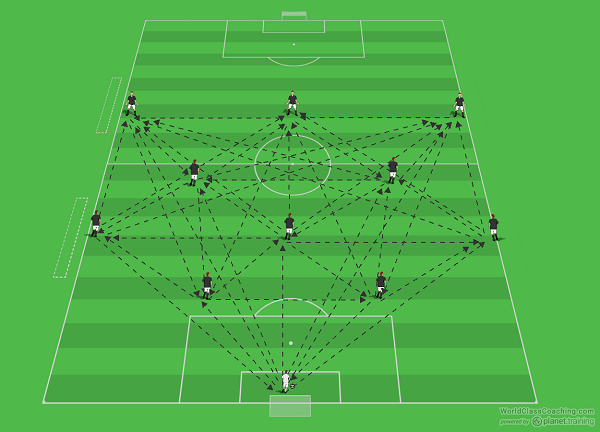
Compare this to a 3-4-3 for example, which many will argue is the most balanced formation:
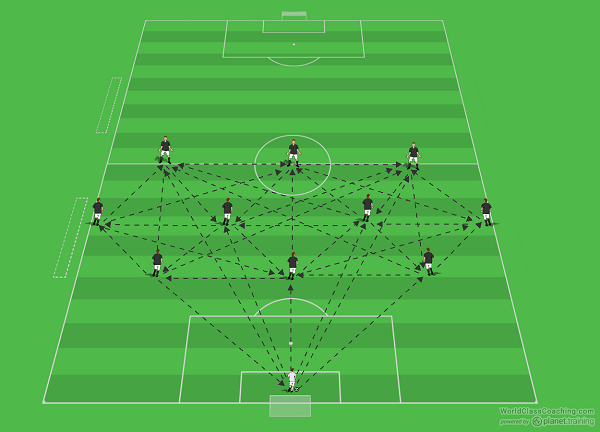
There are only 37 options here. The next diagram shows a 5-3-2 or a 4-4-2 with a diamond mid:
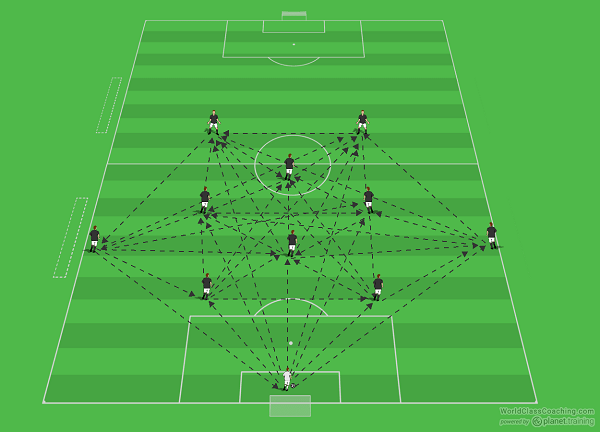
There are 43 options here, however, the balance across the entire field is not there and the outside backs are isolated in their sections.
While this is not a book on the number of passes/connections various formations give, the diagrams clearly show the passing/connection options of Pep’s 4-3-3 (5-5) to be superior or at worst equal to other popular formations. Pep’s formation wins as far as balance across the pitch with exactly 2 players in every section. By inverting the fullbacks and opening up the central space all while expanding and contracting, this shape to create numerical advantages which compact the opposing sides Manchester City is almost guaranteed to always dominate the possession battle.


